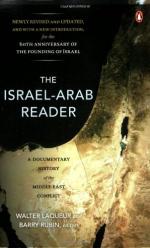
|
| Name: _________________________ | Period: ___________________ |
This test consists of 15 multiple choice questions and 5 short answer questions.
Multiple Choice Questions
1. What was the only course of action for the entire region?
(a) Total war.
(b) United Nation intervention.
(c) United States intervention.
(d) Negotiation.
2. Why do the British want the Jewish immigration to be controlled?
(a) To allow for Arabs to acclimate to the changes.
(b) To allow new comers to be absorbed by the local economy.
(c) To please the Arabs.
(d) To not tax the limited food supply.
3. To whom did Vladimir Zo'ev Jabotinsky writes?
(a) The Palestine Royal Commission.
(b) The New York Post.
(c) The Jewish Concil.
(d) The League of Nation.
4. What differentiated the Palestinian Liberation Organization, the Fatah, the Arab National Movement, and the Popular Front for the Liberation of Palestine. according to Part IV pp214-258?
(a) Their view of Israel.
(b) Their level of commitment.
(c) Their goal for the Palestinian state.
(d) Their degree of radicalism.
5. What did the Law of Return allow?
(a) For Jewish to get a home vacationin Israel.
(b) For Jewish to return to their origine country for free.
(c) For the Arab displaced by the war to return home.
(d) Any jews to immigrate to Israel.
6. How many Jews were allowed to get into Palestine by the White Paper of 1939?
(a) 20000.
(b) 75000.
(c) 150000.
(d) 15000.
7. Who promoted terrorism against Israel?
(a) Iran.
(b) Iraq.
(c) Egypt.
(d) Syria.
8. When did the Arabs begin discussion of secession from the Ottoman Empire?
(a) 1905.
(b) 1906.
(c) 1908.
(d) 1904.
9. What was Emir Feisal's title?
(a) Nabab of Mecca.
(b) Sheriff of Mecca.
(c) King of Mecca.
(d) Calif of Mecca.
10. Who wrote U.N. Resolution 242?
(a) David Ben Gurion.
(b) Markus Estenberg.
(c) Gedeon Rafael.
(d) Ronald Stanbrik.
11. Why would Israel need to change its tactics, according to Hassanain Haykal?
(a) Bad press due to civilian killings.
(b) Fights would move to densely populated areas.
(c) Palestinians would get better weapons.
(d) There was no longer any regular army to fight.
12. What was the basis of the Fatah's creation?
(a) Israel colonization and expansion.
(b) The creation of Israel.
(c) The defeat of Egypt in the Six Days War.
(d) The destruction of Israel.
13. When was the Basle Declaration done?
(a) 1896.
(b) 1901.
(c) 1897.
(d) 1892.
14. What territories did Israel agree to withdrawn from in U.N. Resolution 242?
(a) Jordanian ones.
(b) Egyptian ones.
(c) Negotiated ones.
(d) Those following the Six Day War.
15. Who supported the idea of a Jewish state in Palestine?
(a) England.
(b) Germany.
(c) France
(d) Canada.
Short Answer Questions
1. What did Hassanain Haykal view the conflict for Palestine as a way to do according to Part IV pp. 258-303?
2. What policy did the Anglo-American Committee contain?
3. Where were many concentration camp survivors living at the time of the report of the Anglo-American Committee?
4. What was Ahmed Shukairy's profession?
5. What did the Arabs feel a free Arab state would do?
|
This section contains 487 words (approx. 2 pages at 300 words per page) |

|




